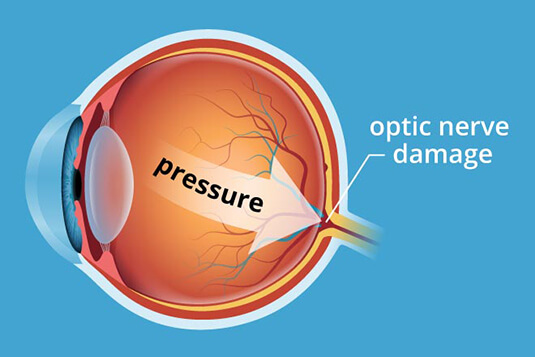Glaucoma
What Is Glaucoma?
Glaucoma is a group of related eye disorders that cause damage to the optic nerve that carries information from the eye to the brain.
In most cases, glaucoma is associated with higher-than-normal pressure inside the eye — a condition called ocular hypertension. But it can also occur when intraocular pressure (IOP) is normal. If untreated or uncontrolled, glaucoma first causes peripheral vision loss and eventually can lead to blindness. Glaucoma is the second-leading cause of blindness worldwide (behind cataracts).
What Are the Types of Glaucoma?

The two major categories of glaucoma are open-angle glaucoma and narrow angle glaucoma. The “angle” in both cases refers to the drainage angle inside the eye that controls the outflow of the watery fluid (aqueous) which is continually being produced inside the eye.
If the aqueous can access the drainage angle, the glaucoma is known as open angle glaucoma. If the drainage angle is blocked and the aqueous cannot reach it, the glaucoma is known as narrow angle glaucoma.
Glaucoma Symptoms
Most types of glaucoma typically cause no pain and produce no symptoms until noticeable vision loss occurs, but with acute angle-closure glaucoma, one experiences sudden symptoms like blurry vision, halos around lights, intense eye pain, nausea and vomiting.
If you have these symptoms, see an eye doctor so steps can be taken to prevent permanent vision loss.
How Does a Doctor Diagnose Glaucoma?
During routine eye exams, a tonometer is used to measure your intraocular pressure, or IOP. Your eye typically is numbed with eye drops, and a small probe gently rests against your eye’s surface. Other tonometers send a puff of air onto your eye’s surface.
An abnormally high IOP reading indicates a problem with the amount of fluid (aqueous humor) in the eye. Either the eye is producing too much fluid, or it’s not draining properly.
Normally, IOP should be below 21 mmHg (millimeters of mercury) — a unit of measurement based on how much force is exerted within a certain defined area.
If your IOP is higher than 30 mmHg, your risk of vision loss from glaucoma is 40 times greater than someone with intraocular pressure of 15 mmHg or lower. This is why glaucoma treatments such as eye drops are designed to keep IOP low.
Other methods of monitoring glaucoma involve the use of sophisticated imaging technology to create baseline images and measurements of the eye’s optic nerve and internal structures.
Then, at specified intervals, additional images and measurements are taken to make sure no changes have occurred that might indicate progressive glaucoma damage.







